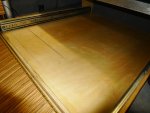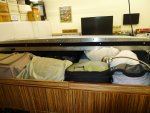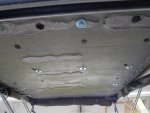And some more:
Just above, there's mention of the Fantastic vent fan installed in the curbside cabin wall. I've got mixed feelings about ER's decision to include this. It works well enough, particularly if you use it to pull air through the cabin from the rear window. But it's pretty sizable, pretty noisy, and the location is weird given that it's located pretty much where your head goes when you sit on the bench.
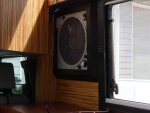
One of the best things about the way my roof opens is that, when unpressurized, the pneumatic struts serve to lock the roof in a closed position and so there are no latches on the exterior as were required in the original system. So if the weather, or bugs, or bad vibes are such that you don't want to go outside, you can set up everything from the inside. But it's not exactly spacious in the JK cockpit, so normal-size guys would need to be abnormally limber to get into the back, and would likely destroy the stock console setup trying. We made the situation way easier by re-configuring the stock center area, cutting down some of the height and fabbing a sturdy supporting structure. The grey and darker grey armrest setup (sadly now too low to be an armrest)

is held on with Velcro, so you can pry it off easily, which reveals a storage cubby (which we made lockable, mostly because it was easy to do so)
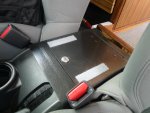
whose top surface is much lower and which is made of sturdy enough steel that you can put all your weight on it. In practice, you kneel on it as you move from front to back and squeeze between the seats, keeping your head low enough to clear the cabin front bulkhead. It's all pretty easy, whereas going between cockpit and cabin was impossible (at least for me) with the flimsy stock console setup.
The JK's small cabin permits only two windows. Fortunately, they are the dual pane acrylic Seitz/Dometic awning windows that allow the maximum ventilation and light for the cutout space. These windows come with an interior cassette that attaches to the frame and contains an top integral bug screen and bottom roller shade. One latches on to the other, letting you move the combination to vary the proportion of screen to light from all-screen to all-shade, or both can be retracted fully.

As mentioned above, the bench seat cushion serves as the basis for the lower bunk. The aisleside trim in front of the bench cushion is removable, and then you can pull the cushion into the aisle to make the bed surface wide enough. But the cushion is not long enough for a bed. The workaround is to pull the passenger seat fully forward and put the recline as forward-tilted as possible. This allows enough space to raise up this platform that supports a properly sized foam pad and stretches the available bed space to better than six feet.

The bench seat cushion has proven to be just a tiny bit too hard for optimum sleeping comfort, though it's a good start. It turns out that putting a lightly inflated small sleeping pad --the smallest Thermarest Prolite, in my case--on top of the cushion makes it all quite plush, and since the Prolite stores so compactly and requires no effort to inflate, it's worth doing, even though it'd be easily possible to sleep straight on the cushion. (By the way, you can get some idea of the excess/luxurious storage space I currently have with the single-bed configuration by noticing the king-sized down pillow I have room to carry.)
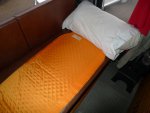
One handy addition was a steel pipe that runs across the with of the back cabin and attaches to the roll cage. One major purpose to attach the grab strap that makes it easier to climb into the rear, but I also got some fancy clip-on shower hooks which I can quickly put on and take off the pipe, and they work perfectly for holding clothes during the night.

Earlier, I mentioned that there was a RAM mount on the front bulkhead. I got myself this pretty cheap 60-LED video camera light from Amazon that runs off AA batteries and has an integral thumbwheel dimmer and attached a RAM ball to the back of it. When deployed, it's a very handy light, as it goes from quite dim to really bright, and with the pivoting mount, I can point it wherever it's most useful. It looks a little different, but it's been a really flexible addition to the cabin lighting.

With the refrigerator, Porta-Potti and batteries and inverter under the curbside bench, there's not a lot of extra room. But because the depth of what went in was limited by the wheel well, there was leftover space above and to the front of the wheel well. Paul cut an access hatch into the bench platform, and I was able to stuff in quite a bit of stuff that I wanted along, but do not need to have readily accessible . . . things like the Jeep manual, tool kits, emergency supplies (like space blankets, firestarters, signal mirrors, some freeze-dried food), a sewing/repair kit and so on. It's a good use of what was otherwise wasted space. That said, I admit to having have to go through this cubby about once a quarter to remember what I've dumped in here.

Paul also cut a panel for access to the battery, inverter and wiring. Not too exciting to look at on a routine basis, but this hatch, in conjunction with the removable end-of-the-bench panel, will make troubleshooting and repairing the main electrical components easier.












